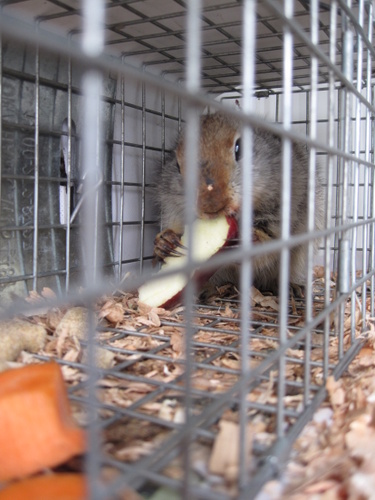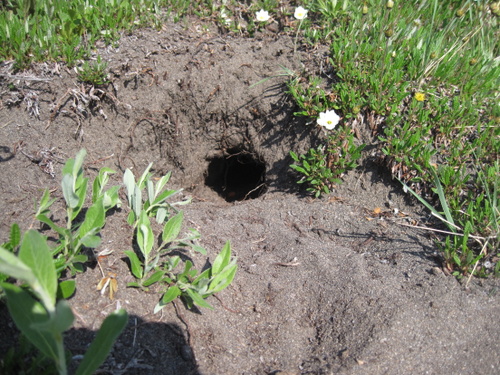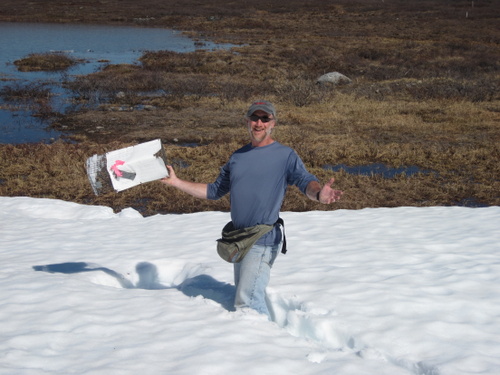Before the school year ended, some of my students asked great questions about my summer work in the Arctic. I think I have touched on most of them during the course of the past month, but I’ll do a quick run-down of some of the kids’ FAQs, just to be sure! Feel free to ask your own questions in the “Ask the Team” section! Before we get started, I wanted to share a fun picture of the Team Squirrel truck.

Squirrel Diet
- What does the Arctic ground squirrel eat? Where do they go to eat? Can they eat big things?
Arctic ground squirrels eat mainly plants and berries that they find on the tundra (they have quite a bit of variety to choose from). Sometimes they eat dead animals. See this post for more information. In the lab, we feed them carrots, apples, and rodent food pellets.

Squirrel Habitat
- Do Arctic ground squirrels live in the ground?
Yes, they sleep, hibernate, and sometimes travel underground in a network of burrow. They spend time above ground each day feeding.
- Why do Arctic ground squirrels dig holes?
There are no trees for the squirrels to live in here in the Arctic, so these animals have paws with nails that are great for digging holes called burrows to live in. Many of the burrows connect to other burrows, creating an underground tunnel system. The squirrels re-use burrows that were dug by squirrels in previous years, too.

Squirrel Appearance/Senses
- What colors can they be?
When we are processing a squirrel in the field or in the lab, we look at its molt. That means we look at the color of its fur. When the squirrels emerge from hibernation, they are a silvery brown color. As the spring/summer continues, they become more of a reddish-brown. They seem to molt at different rates/times and I heard more than one conversation among the scientists discussing theories about why this might be the case.
- What color do they see out of their eyes?
Loren Buck, one of the scientists in charge of Team Squirrel’s research (known as a Principle Investigator), told me that Arctic ground squirrels can see in color, but that their night vision is not very strong.

Squirrel Daily Life
- Do they have a herd or are they by themselves? Are they very mean?
Arctic ground squirrels are usually by themselves, though sometimes it looks like they are playing with each other. They share networks of burrows for moving around, but each squirrel usually has his or her own personal burrow for sleeping. Female squirrels tend to move into a burrow close to their mothers when they “move out” of the family burrow. Males move around from place to place more than females and they tend to fight with each other more than females. We catch squirrels (usually male) with bite marks and scars from fights pretty often.
- What do the Arctic ground squirrels do? What do Arctic ground squirrels do for fun?
When they are not sleeping, the squirrels spend most of their time eating and looking for food. They also chatter to each other across the tundra and run from place to place. Watch this video to see a video of typical Arctic ground squirrel behavior.

- Can Arctic ground squirrels fly?
No, while there are some types of tree squirrels that can “fly” from branch to branch, Arctic ground squirrels can’t. They don’t really have a need to, since there aren’t trees in the Arctic.
- How old do Arctic ground squirrels get?
In the wild, they usually live about 3-5 years. In captivity, they can live much longer.
Squirrel Classification and Reproduction
- Is the Arctic squirrel a mammall?
Arctic ground squirrels are mammals. They have fur, give birth to live young, and nurse their young. You can find out more about how Arctic ground squirrels are classified in this post.
- Do Arctic ground squirrels lay eggs?
No, they give birth to live young. The mother nurses the babies for about six weeks.
Day/Night in the Arctic
- How many hours of sun did you get when you were there? Why does the sun never go down?
In the summer, the Arctic has 24 hours of daylight. It looks like the sun moves in a circle around the top of the sky instead of moving from east to west across the sky like it does each day in Oklahoma. This is because of the tilt of the earth as it rotates each day and its position in its yearly revolution around the sun. During the Arctic summer, the earth is tilted toward the sun, so it is daylight all the time. In the winter, it is tilted away from the sun, so it is dark all the time. You can check out this post for a more detailed explanation.
- Does the moon still come up?
I actually saw the moon a few days ago for the first time since I have been here in the Arctic! The moon continues to revolve around the earth all year long, so it is still there in the summer, but you can’t usually see it very well since the sun is so bright.

Arctic weather
- Is it always cold in Alaska? Does it snow a lot? Does the snow ever melt?
No, it is not always cold in Alaska. Here at Toolik, I have experienced 20 degrees to almost 80 degrees in just one month. The weather changes quickly. Some days it can change from coat weather to shorts weather in just a matter of hours! June, July, and August are the only months that Toolik Field Station’s temperature is above freezing and the temperature often drops to -40 degree Fahrenheit in the winter!
The snow melts in the spring, leaving behind large puddles of standing water that attract bugs and birds. There is a layer of permanently frozen soil in the Arctic called permafrost that never melts, though. Some of this water looks brown and icky. I learned that it is known as “tea water” and that the brown color is from decayed plants and organic material. This water is actually really rich in nutrients for Arctic plants. Even though it looks dirty, it is actually really important to the Arctic ecosystem.
Living in the Arctic (People)
- Was it warm in houses?
There were a few nights that it was pretty cold, but my weatherport and feather-filled sleeping bag kept me warm. Sometimes I run a space heater for a few minutes to take the cold edge off before climbing into bed.
- Was there a shower?
Yes, there are three showers for women to use and three for men to use. I can take two, two-minute showers per week. You take find out more about life at Toolik Field Station on this post.
More Questions?
What do you still wonder about Arctic Ground Squirrels? It’s not too late to post your questions in the “Ask the Team” section of this blog!


Comments